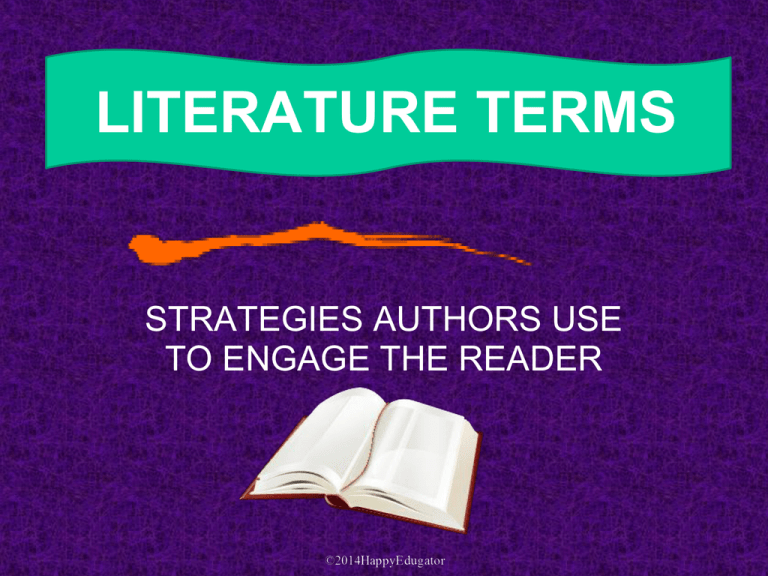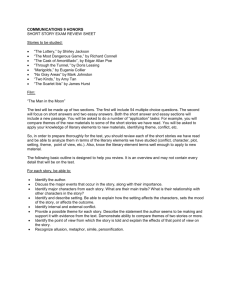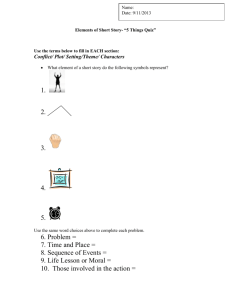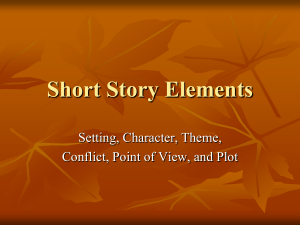Literature Terms
advertisement

LITERATURE TERMS STRATEGIES AUTHORS USE TO ENGAGE THE READER Literature Terms The following slides are a collection of literary terms that you may find as you study and analyze great pieces of literature. The terms are listed in alphabetical order, so if you need to refer back to a term, you can do so quickly and easily. ©2014HappyEdugator *Allegory • a story with a double meaning, in which the characters and events are representing other things and symbolize a deeper, often spiritual or moral meaning. • Ex. The Lion the Witch and the Wardrobe • Ex. Billy Budd ©2014HappyEdugator *Alliteration • is the repetition of initial sounds in adjoining words • usually more than 2 words • ex. “Peter Piper picked a peck of pickled peppers…” ©2014HappyEdugator *Allusion • is a brief reference to a person, event, or place, real or fictitious, or to another work of fiction or a piece of art. • ex. In Gary Paulsen’s book, The River, Brian thinks the raft looks like something out of Huckleberry Finn. ©2014HappyEdugator Protagonist • The main character in a piece of literature who struggles with the main conflict. • Who would this be in Holes? • Who would this be in Maniac Magee? • Who would this be in The Land of Stories? Antagonist • The person (ex. Another character) or thing (ex. A blizzard) that causes the conflict for the protagonist. • Who or What was the antagonist in Holes? • Who or What was the antagonist in Maniac Magee? • Who or What was the antagonist in The Land of Stories? Characterization (Can be Direct or Indirect) • is the technique used by a writer to develop character traits. (1) showing the character's appearance (2) displaying the character's actions (3) revealing the character's thoughts (4) allowing the character to speak (5) receiving the reactions of others. ©2014HappyEdugator Types of Characters • Static Character-A character whose personality does not change throughout a piece of literature. Give an example from Holes. • Dynamic Character-A character whose personality changes as the result of conflicts. Give an example from Holes. Conflict • is the opposition between or among characters or forces in a literary work that creates or stimulates the action of the plot. • Conflict may be internal or external. ©2014HappyEdugator *Conflict Cont. (1) Character vs. Self (making a difficult decision) (2) Character vs. Character (3) Character vs. Nature (a storm) (4) Character vs. Society (unfairness in society) (5) Character vs. Machine ©2014HappyEdugator Flashback • An interruption of the plot to go back earlier in time. • Ex. Holes Foreshadowing • is a literary device in which an author drops subtle hints about plot developments to come later in the story. ©2014HappyEdugator *FIGURATIVE LANGUAGE • TO DESCRIBE SOMETHING BY COMPARING IT TO SOMETHING ELSE. o o o o o o Simile Analogy Metaphor Personification Hyperbole Idiom ©2014HappyEdugator *Simile • is a comparison between two different things using ‘like’ or ‘as’. • ex. He jumped as if his feet were on fire! ©2014HappyEdugator *Analogy • is the comparison of two pairs that have the same relationship. • ex. Teachers are the salt as students are the pepper in the classroom… ©2014HappyEdugator *Metaphor • is a comparison of two unlike things using the verb "to be" (am, are, was, were, etc.) instead of using ‘like’ or ‘as’. • Example: Her words are butterflies. • Example: I am an empty house ready for a new owner. ©2014HappyEdugator Personification • is giving human qualities to inanimate objects. • Example: The sun smiled down on us. ©2014HappyEdugator *Hyperbole • is a deliberate and obvious exaggeration used for effect • Example: I rang you a zillion times and you never answered! • Example: Last night seemed to last forever. ©2014HappyEdugator Idiom • Literally ideas as expressions. They develop from older usage, where the words mean something other than their literal meaning. • Example: A chip on your shoulder • This is a grudge for a previous experience. It can apply to people, or subjects. • He’s got a real chip on his shoulder about the change in his schedule. Genre • A French word referring to the “kind” or “type” of literature • Fiction Examples: science fiction, historical fiction, realistic fiction, mystery, fantasy • Nonfiction Examples: Biography, Essay, Autobiography, Article, Memoir, Journal, Editorial Imagery • is writing or language that evokes one or all of the five senses. ©2014HappyEdugator *Irony • A clash between what actually happens and what might be expected to happen. • Example: The fireman’s house burnt down. ©2014HappyEdugator LITERAL LANGUAGE • TO DESCRIBE SOMETHING AS IT IS. You must take literal language word for word. (literally) It is the opposite of figurative language. ©2014HappyEdugator Motif • is an important and sometimes recurring theme or idea in a work of literature. ©2014HappyEdugator Mood • is the atmosphere or state of mind of a reader in reaction to a story or poem ©2014HappyEdugator *Onomatopoeia • is the use of a word to imitate sound • Example: The strumming of the guitar ©2014HappyEdugator *Oxymoron • is putting two contradictory words together. • Example: Jumbo shrimp HUH? ©2014HappyEdugator *Paradox • is a statement, proposition, or situation that seems to be absurd or contradictory, but actually may be true. • Example: "I know that I know nothing." • If you know nothing, then you know something, which cannot be “nothing.” HMMMM… ©2014HappyEdugator Plot- The sequence of events that make up a story Exposition: The author introduces the main characters, the conflict, and establishes the setting. Inciting Incident: The plot event that incites the conflict. Rising Action: The plot events leading up to the climax. Climax: The most exciting or suspenseful moment in a novel or short story. Falling Action: The plot events occurring after the climax. Resolution: The moment in plot where the conflict is resolved. Point of View • is the perspective on events of the narrator or a particular character in a story. • 1st person: the pronoun “I” is used to tell the story. • 2nd person: “you” is used to make the reader a part of the action • 3rd person: The pronouns “he” or “she” is generally used in this perspective. • 3rd person Omniscient-knows the thoughts and feelings of characters ©2014HappyEdugator Satire • is the use of wit, especially irony, sarcasm, and ridicule, to critique politics and society. • Example: South Park • Example: The Simpsons ©2014HappyEdugator Setting • is the time and location in which a story takes place. ©2014HappyEdugator Symbolism • is the use of symbols to represent something abstract by something concrete. • ex. A book worm symbolizes someone who loves to read ©2014HappyEdugator Theme • is a main idea in a story, or a message or lesson the author wants to give the reader. • How to find the theme in a work: 1. Ask yourself, “What is the work about?” ___________ 2. Ask yourself, “What about __________?” • Theme is NEVER just one word. • “Love” isn’t a theme / “Love endures all things” is a theme ©2014HappyEdugator Tone • is the author’s attitude toward the subject and/or toward the audience implied in a literary work. ©2014HappyEdugator Examples and Practice Go to http://www.buzzle.com/articles/imageryexamples.html





